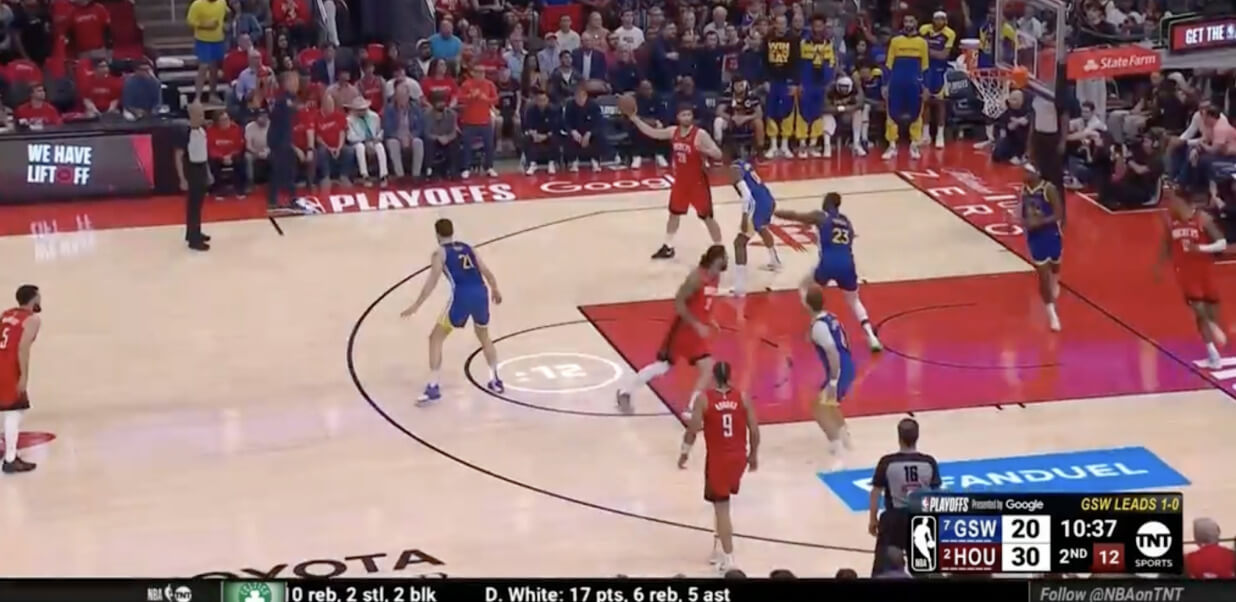
SAN FRANCISCO — Twenty-four hours until tip, the largest swing factor in Game 3 between the Golden State Warriors and Houston Rockets is a giant question mark.
Jimmy Butler’s status remains uncertain. He’s getting constant treatment on the painful deep glute contusion he suffered during a nasty fall in Game 2. Warriors coach Steve Kerr said he was “relatively optimistic” Butler would get clearance after Friday’s practice.
Advertisement
“We know he’s willing to play through anything,” Kerr said. “So, we’ll see. This is a day-to-day thing for sure and we’ll see how he feels tomorrow. But I think there’s a chance he plays.”
If Butler does play, it’s fair to wonder how limited he will be in what has been a wrestling match of a series. If he doesn’t play, that generates an entirely new set of challenges for the Warriors and adjustments for both teams.
Let’s break it down with The Athletic’s Anthony Slater and Kelly Iko, our reporters covering both sides of the series.
What must change for each specific team as the series shifts to San Francisco?
Slater: The Warriors’ defense on Jalen Green and, more specifically, the amount of possessions they left a center out there for him to target and attack in space.
In Game 1, Quinten Post and Kevon Looney were only on the floor a combined 21 minutes, partially separated from Green and used against Houston’s two-big lineups. Green went 3-of-15 shooting against a scrambling, smaller, versatile defensive look. He didn’t have much freedom to roam and space to shoot.
In Game 2, responding mostly to Butler’s early departure, Kerr upsized his rotation and played Looney and Post a combined 38 minutes. Green looked sharper and would’ve shot it better regardless, but a handful of the offensive possessions that delivered him momentum toward a 38-point night came in high screen or switching action when he was able to operate against a dropping or backpedaling Looney or Post.
Post was the most vulnerable target. Here are three examples of Green hunting the rookie center. He is put in high-screen action and Green gets a short-range jumper, a driving dunk and a floater.
If Butler is cleared for a normal workload, this becomes a minor issue for the Warriors. They’ll remain primarily small. But if Butler is limited or out, it generates a difficult decision for Kerr. Post provides the floor spacing the non-Butler lineups need. He started the second half of Game 2 and hit four 3s. But he’s also a sitting duck on defense and this is a series that the Warriors need to win on that end.
Advertisement
Iko: How the Rockets combat the Warriors’ multiple zone looks, particularly against 1-3-1 when both Alperen Şengün and Steven Adams are on the floor.
During the regular season, Houston often found itself in a bind whenever teams would switch to a zone defense — exposing the Rockets’ lack of consistent spacing and half-court struggles. In the playoffs, those inefficiencies are magnified. According to Synergy, the Rockets are scoring a measly .300 points per possession against the Warriors’ zone, which ranks second-worst among playoff teams. (Ironically, Golden State is dead last.)
The issue for the Rockets is it’s difficult to determine which zone the Warriors are using in real-time because of their ability to toggle between them so quickly. From an outside perspective, it certainly looks like Golden State’s defense is fine-tuned to shapeshift depending on which Rockets player has the ball in their hands.
In this possession early in the second quarter, Şengün dribbles the ball up the floor and relinquishes it to Fred VanVleet after crossing half court. Almost immediately, the Warriors take on a box-and-1 shape, occupying the elbows and boxes, while pressuring the ballhandler.

A few seconds later, the ball is back in Şengün’s hands and it shifts to a 1-3-1 — the purpose of which is to protect the middle of the floor, with Draymond Green in a “free safety” role.

Şengün attempts to throw an entry pass to Adams, who smartly repositions himself in the restricted area, but Draymond is already there to break up the play.

The benefits of the Şengün-Adams frontcourt are clear — Houston enjoys a monumental advantage on the offensive glass (The Rockets are a plus-33 in rebounds on the entire series) and have been a stingy defensive pairing, holding Golden State to a 76.2 offensive rating in 21 minutes together. But there are clear drawbacks that need tweaking before Game 3.
Advertisement
“We know what we need to do against it,” Rockets head coach Ime Udoka said following practice on Friday. “Not be stagnant and move the ball around the perimeter. You still want to attack with the pass or dribble, find the middle and usually breaks it down. We worked on some things we can do against their 1-3-1 today.”
Which role player will enter the spotlight?
Slater: Jonathan Kuminga.
It sounds simple to just demand Kuminga remain as ready as Gui Santos or Pat Spencer to flip the switch from ice-cold to fifth gear in an instant. But that’s just not the reality of the personalities and dynamics at play.
Santos and Spencer have clawed into the NBA on their ability to find a niche, out-hustle and out-work opponents. It’s a refined and valued professional skill — mastering the 11th-man role. It’s also why Kerr has come to prefer Santos over Kuminga as that extra end-of-the-rotation two-minute wing to throw out as an energy spark in this series. It’s Santos’ specialty.
Kuminga’s reality is different and it isn’t just about his own lofty dreams. Every decision-maker in the organization, at some point, has labeled Kuminga as their potential future star, from the owner to the general manager to the coaches to his famous teammates, protecting him in trade talks, delivering him Draymond Green’s starting spot, calling him “next-up” and stating that he’s “turned the corner” after long stretches of high-impact, high-production games — and he’s had numerous month-long surges in his first four seasons.
Kuminga has always been at his best — energy, all-in attitude, rebounding and cutting force, commitment to the game plan — when he’s felt a level of belief behind him. That isn’t currently there. However justified Kerr’s rotation choices might be, Kuminga’s benching has bred a feeling of abandonment, an inevitability of the end of his Warriors tenure.
So it shouldn’t be too much of a surprise that he wasn’t his sharpest self when Kerr called him out of the bullpen in Game 2 following Butler’s injury. He’d spent the previous week trying to suppress his competitiveness to remain a positive teammate and put on a brave face after what has been an embarrassing demotion two months before his restricted free agency. Two seconds later, he was jolted into the NBA’s most physical playoff series with a microscope on his every move.
Advertisement
This is where Butler’s unclear status is tricky for the Warriors. If they knew he was definitely out, it’d be simpler to spend two days amping up Kuminga, guaranteeing him 25 minutes, telling him they’d only have a shot against the Rockets if he brought that level of downhill force and aggression and focus that helped them beat Houston twice in the regular season without Curry.
Kuminga had 23 and 33 points in those games. Without Butler, they need his scoring and could even feed into more individual motives. Blow up in a big Game 3 performance and theoretically improve your market this summer.
But Butler might play. If he does, Kerr will presumably (and justifiably) fall back into the rotation that delivered them a Game 1 win and so much more the last two months. That leaves Kuminga out in the cold, boxed out by Butler’s high-minute totals and the need for an energy spark like Santos in the more fringe role.
So Kuminga might not matter at all in Game 3. But without Butler — or if Butler’s physical scoring style is compromised — Kuminga may represent the Warriors’ only legitimate counter to remain competitive in the series.
Iko: It needs to be Fred VanVleet.
Through two games, the 31-year-old guard is struggling to score, averaging just 8.6 points while shooting 22.2 percent from the field and just 15 percent from 3. There were ebbs and flows to VanVleet’s conversion rate during the regular season, but he’ll need to regain efficiency if Houston has any realistic shot at advancing.
Game 3 will be the first time this young core will be put in that sort of an environment, on the road against a team that already stole homecourt advantage. The energy in the building will be momentous and they’ll need to lean on VanVleet’s experience and poise to avoid any emotional letdowns.
As a playmaker, VanVleet’s ball security is impressive (4.5 assist-to-turnover ratio) and the veteran guard tends to bring defensive intensity, whether at the point of attack or preventing transitional opportunities with his active hands. I’m just not sure how long the Rockets can keep this up if VanVleet is averaging single-digits a night.
Advertisement
Name another factor or stat that could define the result of Game 3.
Slater: Brandin Podziemski’s recovery over the last two days.
He’s been mostly great for the Warriors the last couple months, providing all the supplementary scoring, rebounding, passing and defensive toughness they’ve needed as a fourth starter and closer.
Podziemski was a major part of the Game 1 win. But he was also a major reason for the Game 2 loss. Podziemski ate something that didn’t agree with him at some point on Tuesday or Wednesday. He spent the hours leading up to the game feeling terrible. He tried to play, but was completely ineffective in 14 minutes, needing intravenous fluids at halftime to even attempt to play in the second half.
Podziemski is expected to play in Game 3. He isn’t listed on the injury report. But his ability to be the energized version that helped turn their season around the last two months is crucial, not the wobbly version who tried to gut it out on Wednesday night.
Iko: Transition opportunities and Houston’s ability (or lack thereof) to capitalize on them.
Houston was an average transition team in terms of frequency during the season. This makes some sense given how physical their defense is, their ability to generate turnovers and using their athletes in the open floor.
The issue for the Rockets is what happens when they find themselves in transition. According to NBA.com tracking data, Houston’s 1.11 points per chance on such possessions places them in the 27th percentile. To make matters worse, the Warriors have punished the Rockets at the other end, ranking third in frequency and second in points per chance, per Synergy.
One main issue for Houston in transition is their personnel at the time of those chances. The Rockets are sixth in 3-point attempts in transition but 11th out of 16 playoff teams in conversion rate.
Advertisement
Give a ton of credit to Golden State’s defense, which has prevented Houston from getting out and running. The Rockets are in the bottom-three in playoff transition chances and are 12th in points per play, scoring just four and 10 fast-break points in Games 1 and 2, respectively — a far cry from the 23.4 points they averaged during the regular season. This series has become a full-blown slugfest, but there are still pockets where the Rockets can exploit them in the open floor. It all stems from decision-making, spacing and personnel.
(Top photo of Jalen Green going up for a layup: Tim Warner /Getty Images)
This news was originally published on this post .







Be the first to leave a comment